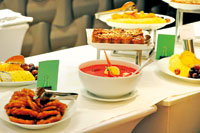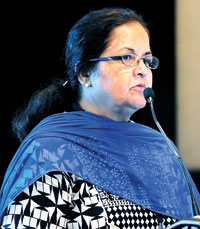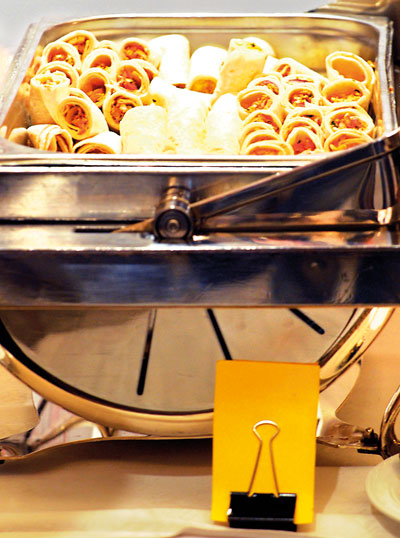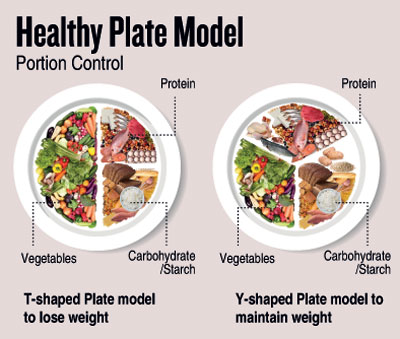Red, Amber and Green, not road rules but food rules
View(s):By Kumudini Hettiarachchi

Green flagged fruit platter among the array of desserts. Pix by Amila Gamage
The session just before lunch was short and to the point. It was meant to be for an hour but lasted only 15 minutes. A few slides and out she walked to the sumptuous buffet laid out for all the delegates, local and foreign, who were attending a medical conference at a five-star hotel in Colombo.
As the delegates were ladling large portions of fried food onto their plates or having tucked into the main meal were gathering around the tempting array of desserts including some overflowing with chocolate, Kavita Kapur armed with ‘Red’, ‘Amber’ and ‘Green’ paper flags was moving around ‘flagging’ the food.
The rice dishes came first – the fried rice and other exotic dishes lathered in oil, all got ‘Reds’, while it was only the plain rice that got a ‘Green’. Aren’t brinjals (aubergine) good, someone protested, having taken a large portion. “Yes,” said Ms. Kapur, “brinjal is very good, but see how the pieces are swimming in oil.”

Nutritionist Kavita Kapur
The desserts suffered the same fate. “Everything is ‘Red’,” she said with a sweep of her hand, except the fruits which were awarded a ‘Green’, while the salad-table without any dressing got a ‘Green’ as well.
This was all part of the ‘Skill Drill’ on Practical Educational Tools for Healthy Eating that Ms. Kapur, a well-known nutritionist from India, was holding on September 8 before the inauguration of the ‘1st Asia-Pacific Symposium on Diabetes, Hypertension, Metabolic Syndrome and Pregnancy’. The three-day symposium was held by the network Diabetes in Pregnancy Asia-Pacific (DIPAP) and the South Asian Initiative for Diabetes in Pregnancy (SAIDIP).
 For meal plans for expectant mothers, the advice from Ms. Kapur was simple. “Follow the Traffic Light Diet.”
For meal plans for expectant mothers, the advice from Ms. Kapur was simple. “Follow the Traffic Light Diet.”
It is called by many names including ‘Stoplight Diet’, ‘Go-Slow-whoa’ and ‘Signposts’, but what it does is food mapping under ‘Red’, ‘Amber’ and ‘Green’.
These are alerts, says Ms. Kapur pointing the way:
- Red — means the food is high in fat, sugars or salt. It is fine to eat this food occasionally or as a treat, but think about how often you choose it and how much of it you eat.
- Amber – means the food has fat, sugars or salt in medium amounts, making it a permissible food, although going for green is even better.
- Green – means the food is low in fat, sugars or salt which makes it a healthier choice.
The examples flow forth easily:
- Green – steamed brown rice, whole grain bread, whole wheat plain rotti, steamed grilled fish, cucumber salad & fresh fruit.
- Amber — steamed white rice, white bread, maida rotti/naan, stir-fried fish, Russian salad with Mayonnaise and unsweetened fruit juice.
- Red – Deep-fried chicken rice, cakes, cookies, croissants, godamba rotti, fried-salted fish, crispy-fried vegetable fritters, dried fruit and canned fruit juice. Even when advising expectant mothers to eat the ‘Green’ or ‘Amber’ food, a word of caution is very important, she said, adding that they should be told how much to eat.
 “If you say, have fish, the expectant mother may eat a huge portion,” pointed out Ms. Kapur. This is why it is important to follow the healthy-plate model. If the mother has to lose weight, then it would be the T-junction model and if she has to maintain her weight it would be the Y-junction model. (See graphic)
“If you say, have fish, the expectant mother may eat a huge portion,” pointed out Ms. Kapur. This is why it is important to follow the healthy-plate model. If the mother has to lose weight, then it would be the T-junction model and if she has to maintain her weight it would be the Y-junction model. (See graphic)
Meanwhile, the Colombo Declaration issued at the conclusion of the symposium demanded increased focus on maternal health to deal with the diabetes onslaught in South Asia and urgent action to address the link between maternal health and diabetes as a ‘public health priority’.
Focusing on hyperglycemia in pregnancy popularly referred to as gestational
Diabetes, the declaration said there is a unique opportunity to integrate services to improve mother and newborn health and address prevention of non-communicable diseases (NCDs) such as diabetes, hypertension, cardiovascular diseases and stroke.
Hyperglycemia is one of the most common medical condition affecting women during pregnancy – an estimated 25% of live births in South Asia are impacted by it. These pregnancies are subject to increased risk of complications such as hypertension, obstructed labour, postpartum hemorrhage, infections, stillbirths, premature delivery, newborn deaths due to respiratory problems, hypoglycemia and birth injuries, it said, adding that “South Asian women are considered to have the greatest vulnerability for GDM, yet routine testing of all pregnant women is not done”.
 Without preventive care almost half of the women with GDM develop type 2 diabetes and significant proportions develop premature cardiovascular disease within 10 years of childbirth. Children born to women with GDM are also at very high risk of obesity, early onset type 2 diabetes and cardiovascular disease, whereby, hyperglycemia in pregnancy perpetuates the risk of diabetes into the next generation.
Without preventive care almost half of the women with GDM develop type 2 diabetes and significant proportions develop premature cardiovascular disease within 10 years of childbirth. Children born to women with GDM are also at very high risk of obesity, early onset type 2 diabetes and cardiovascular disease, whereby, hyperglycemia in pregnancy perpetuates the risk of diabetes into the next generation.
The three-day symposium was held by the network Diabetes in Pregnancy Asia-Pacific (DIPAP) and the South Asian Initiative for Diabetes in Pregnancy (SAIDIP). The symposium was supported by the Health Ministry, the World Health Organization (Sri Lanka Country Office) and the World Diabetes Foundation. The Co-Presidents of the symposium were Prof Chandrika Wijeyaratne and ….


